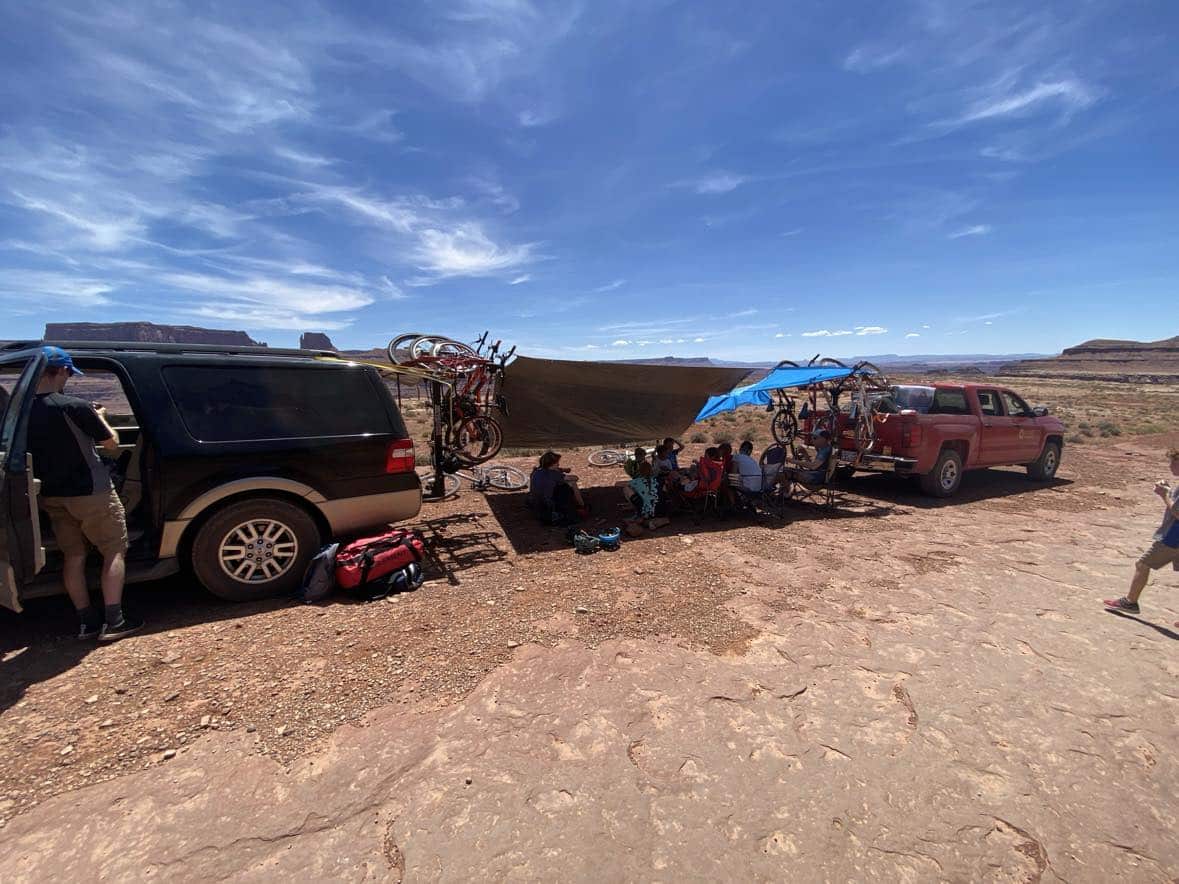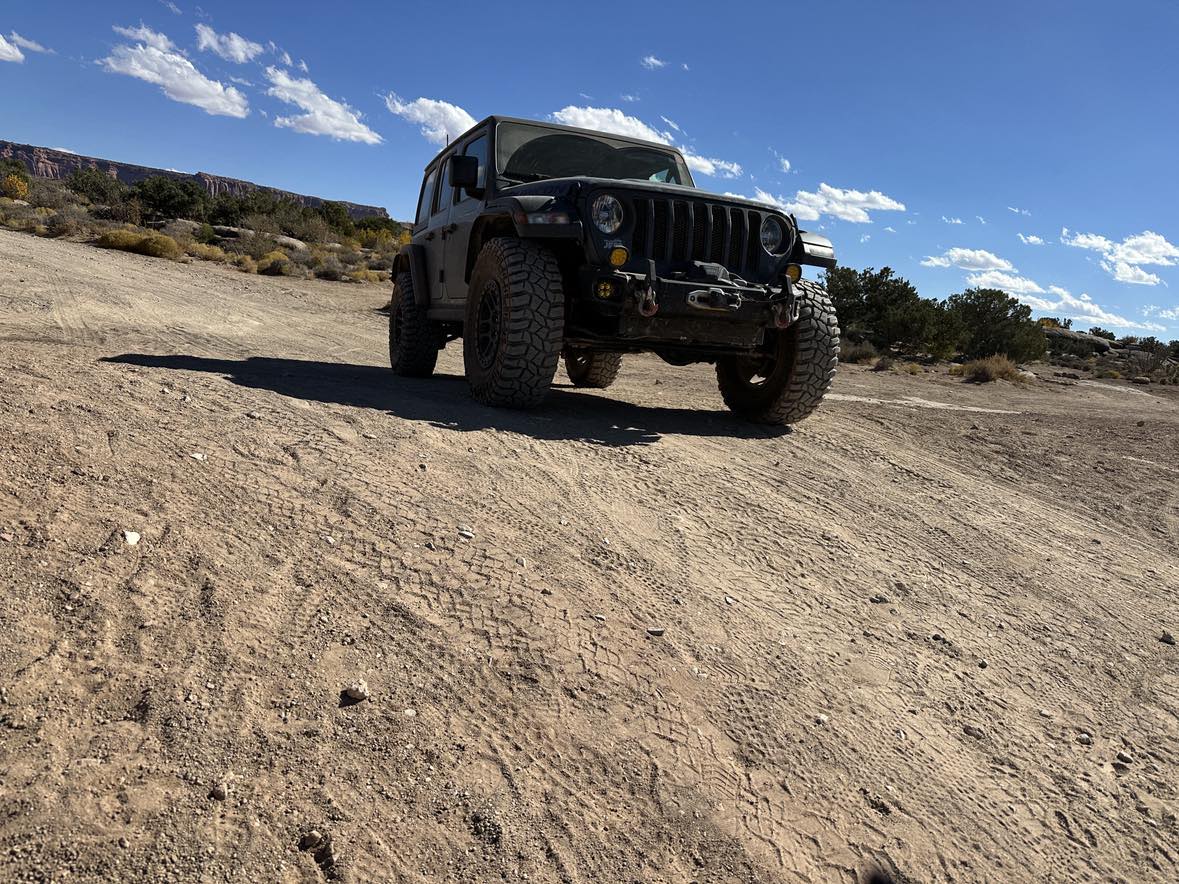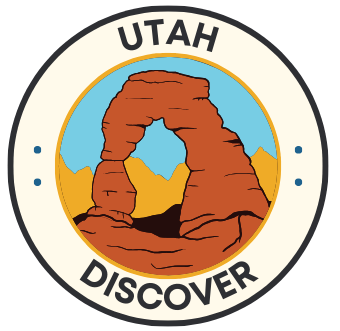The White Rim Road in Canyonlands National Park is a bucket-list adventure for off-road enthusiasts. This 100-mile loop through the Island in the Sky District of Canyonlands offers unparalleled views of dramatic canyons, backcountry arches, striking rock formations, and incredible desert landscapes. But driving the White Rim Road is no casual trip – it requires preparation, permits, experience, and a sense of adventure. It’s wild, rugged, remote, and somehow keeps pulling us back year after year. As Utah locals, we’ve had a trip there every year for the last 3 years and are already planning our next trip. Here’s everything you need to know about tackling this iconic 4×4 road through Canyonlands.

How Hard is it to Drive the White Rim Road?
Driving the White Rim Road is a challenging endeavor. The road is unpaved and requires a high-clearance, four-wheel-drive vehicle. Expect rocky terrain, steep switchbacks, and potentially muddy or sandy roads (we’ve seen both in the same places depending on the year and the weather). Some sections, such as the infamous Murphy Hogback, feature narrow, exposed roads that can be nerve-wracking for inexperienced drivers. Make sure you are comfortable with off-road and cliff-exposed driving and vehicle recovery techniques before embarking on this journey.

On our most recent trip, we stopped to regroup at the bottom of the Shafer Trail, just a few miles into our trip, and ran into a few other couples who were planning to do the drive. They were so terrified by the first decent, that they decided to bail on their trip and drive out Potash Road and back into Moab instead of continuing. Do your homework before you go.
This video right here shows what the first half of the trail is like. Truthfully, the video makes a lot of it look easier and smoother than it is (thanks to great cameras for image stabilization). Make sure to watch all the way to the end though some more technical areas.
What Kind of Car Is Needed to Drive the White Rim?
To drive the White Rim, you’ll need a high clearance 4×4 vehicle. Personally, our group has always done it in stock SUV’s and Trucks (making the sure SUV has real 4×4 including 4-low). However, I know others who insist on doing the drive with a lifted 4×4 specific vehicle. We drive a stock 2012 Ford Expedition EL, and we’ve done it with friends in a truck and other friends in a 2006 Toyota Sequoia.

Not sure which is best for you? I think a lot of it depends on driving skills and comfort level. If you have a lot of experience with offroad driving, you can take just about any 4×4 since you’ll be able to comfortably get up climbs, and also to avoid obstacles. If you don’t have as much experience, you’ll want a vehicle with higher than standard clearance.

How to Get Permits
A permit is required to drive the White Rim Road, and they’re in high demand. You can obtain one from the National Park Service. Permits are limited to overnight permit holders (check here for when permits are available for your dates), and 15 vehicles per day. Day use permits are available the day before your trip, but only 15 day-use vehicles are allowed on the road each day (and that includes bikes). You can get day permits online or in person at the Island in the Sky visitor center.
Permits go especially quickly on weekends, holidays, and in spring and fall when the weather is good.
Can You Drive the White Rim Road in 1 Day?
While driving the White Rim Road in 1 day is possible, it may not be enjoyable. Driving the White Rim road is pretty slow going, considerably slower than riding it on a bike or a motorcycle, due to how rocky it is. To drive the full White Rim Road, ti would probably take about 15 hours or rough driving. While it’s possible, most people won’t think it’s very pleasant, and you’ll have almost no time to enjoy the views, scenery and solitude.
The preferred way to drive the White Rim is with an overnight permit. Most visitors choose to take 2-3 days to drive the whole thing, depending on the campsites they are able to secure.

Driving Part of the White Rim Road Without Permits
While a permit is required to drive the entire White Rim trail, you can drive the beginning and end of it without a permit, so there is a little loophole. Here’s where you can drive:
Down the Shafer Trail: You can drive down the switchbacks of the Shafer Trail and onto Potash Road back into Moab. If you turn off at the bottom of the Shafer Trail, you won’t need a permit.
Down Mineral Bottom Road: You can drive down Mineral Bottom Road down the switchbacks and to the Mineral Bottom Boat Ramp. You can also drive about 2 miles south on the road, until the road enters Canyonlands National Park. Once you enter the National park, permits are required!
Obstacles to Watch Out For on White Rim
There are several things that make driving the White Rim challenging. Here are some that you need to be aware of before you plan your trip.
- Steep Grades and Switchbacks: The Shafer Trail and Murphy Hogback are particularly steep and narrow with large dropoffs.
- Rocky Terrain: Be prepared for rough, uneven surfaces that can be tough on tires and suspension. Having some repair supplies and a tow strap are essential.
- Muddy Conditions: After rain, sections of the road can become very muddy and difficult to navigate.
- River Crossings: Some parts of the trail might involve shallow water crossings, depending on recent weather.
- Sandy Washes: Depending on the year, you’ll find areas of the trail that are covered in deep sand, and others that have several feet of silt that’s been deposited on them. Knowing how to drive in sand (and get yourself out of it) is essential.

Most Difficult Sections of the White Rim Road
There are a couple of difficult sections that you need to be aware of before you drive the White Rim to make sure you’re up for the challenge. The first is Murphys Hogback. The east side has a very steep hill with large dropoffs on the side. The first time we drove the road in 2022 it was incredibly sandy (almost too sandy to walk or bike up), and there are several good sized rocks in the middle of the trail that you’ll go over. The road is narrow here, so there are serious consequences if you’re not careful.

The second technical area of the White Rim Road is at Hardscrabble. Hardscrabble is a longer climb with several switchbacks along the way. While at first it may appear straightforward, the switchbacks are very steep. On our most recent trip in May of 2024, a couple of the switchbacks had large potholes that required a spotter to avoid (since you can barely see them over your hood). The road is narrow and steep, but it’s not too rocky until you get to the final little climb before the top. When you’re driving Hardscrabble, you’ll need to be aware of other cars going up or down since there are very few places to pass and it’s incredibly difficult to back down or up it safely. You’ll need your 4-low here.

Necessary Safety Equipment for Cars
If you’re doing the White Rim, you’ll need to be prepared to be fully self supported, and to get yourself off the trail if you have a problem. In all the years that we’ve done the trail, we’ve only seen a ranger down there once, so don’t think they’ll be there to save the day.
- A high-clearance, four-wheel-drive vehicle
- A full-size spare tire and a tire repair kit
- A jack and other basic vehicle repair tools
- A tow strap
- Plenty of water (at least one gallon per person per day + some extra in case you get stranded)
- Food and snacks
- A detailed map or GPS device (don’t rely on cell service since you won’t get much here)
- A first-aid kit
- Sun protection (hats, sunscreen, sunglasses)
- Warm clothing and sleeping bags (even if not camping, in case of an emergency)
We also recommend that you don’t drive it alone and that you have at least 1 other vehicle with you in case of a problem. Implementing the Buddy System on the trail can be a literal lifesaver if you run into mechanical problems and need help.
We are often asked if we carry extra gas when we drive the White Rim, and the answer is NO. We simply fill up our cars and trucks at the Chevron on Hwy 191, just before you turn off on 313 to go to Canyonlands. We’ve never used more than 1/2 tank in any of our cars. If you’re taking a motorcycle, you may need extra gas. On one of our trips we had a motorcycle come with us (when we were doing a 1 day White Rim bike trip) and they ran out of gas almost at the top the the Shafer trail with only a few miles to go. Thankfully, we had another support vehicle with a gas can for the motorcycle, since we anticipated this with the small bike gas tank.


Things to Stop and See Along the White Rim Road
- Colorado River Overlook: Provides sweeping views of the Colorado River far below.
- Musselman Arch: A natural rock bridge that’s just off the road and offers a great photo opportunity.
- Lathrop Canyon: A scenic side trip that leads down to the Colorado River.
- Monument Basin: Canyon with giant sandstone monuments all throughout. Our favorite spot for photos!
- White Crack: The most remote campsite on the route, offering stunning views of the confluence of the Green and Colorado Rivers. About 1.5 miles off the trail.
- Holeman Slot Canyon: A narrow, twisting slot canyon that’s perfect for exploring on foot. If you want to go far, make sure to take a hand line with you to get down and back up some of the bigger drops.
- Fort Bottom Ruin: An ancient Ancestral Puebloan ruin located on a butte overlooking the Green River. The hike is 1.7 miles to get here and is perfect if you’re camping at Hardscrabble or Potato Bottom and have a shorter day with time to fill.
- Upheaval Canyon: A dramatic geological formation that is a must-see, though the canyon is pretty sandy.
- Mineral Bottom Boat Ramp: A great spot to put in for a permitted float on the Green River. Since most of the other river access areas have thick tamarisk trees growing there, this is a great place to get into the river. Note: It’s usually SUPER MUDDY getting in here so be prepared for that.





Rules for Driving the White Rim
- Permits: Ensure you have the required permit and backcountry camping permits if needed.
- Group Size: Limit your group size to the number specified on your permit. Total registered group members cannot exceed 15.
- Leave No Trace: Pack out all trash and minimize your impact on the environment.
- Camping: Only camp in designated sites.
- Stay on the Road: Do not drive off the designated route to protect the fragile desert ecosystem.
- Fire Restrictions: No open fires are allowed.
- Respect Wildlife: Keep a safe distance from all animals and do not feed them.

A Note on Biking the White Rim
We have always driven the White Rim as car support for bikers. Truthfully, I really believe that the White Rim is best enjoyed by bike if you’ve got the fitness for it. A majority of people we’ve seen when on the trail are offering bike support as well with the occasional driving only group. If you’re doing bike support, make sure to have a very solid rack, and we also recommend securing it to your car with some extra straps (you’ll likely want your bike there too, so you want to minimize bike bouncing. You can read all about biking the White Rim here.

Are You Ready to Drive the White Rim??
Hopefully this article has helped educate and inspire you to drive the White Rim Road in Canyonlands National Park. It’s one of the best remote desert roads and the scenery is out of this world. Whether you’re marveling at the views from the Colorado River Overlook or exploring the ancient ruins of Fort Bottom, the White Rim Road promises an off-road adventure like no other.

